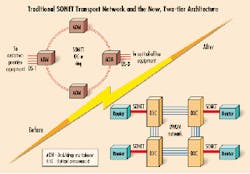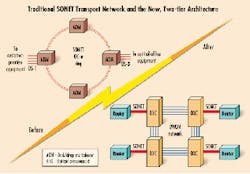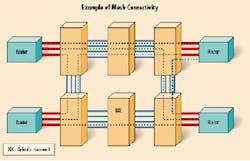Next-generation intelligent, high-speed transport networks
Data traffic is spearheading service providers' moves from the traditional Synchronous Optical Network ring architectures to a two-tier data network.
Carl Blume
IronBridge Networks
Synchronous Optical Network (SONET) remains the dominant wide-area-network (WAN) protocol used by North American service providers. It is an American National Standards Institute (ANSI) protocol for the high-speed transport of time-division multiplexed (TDM) voice and data services. SONET was designed to support multipoint, self-healing ring topologies over broadband fiber-optic media. Together with fiber optics, SONET is credited with transforming the North American public-switched telephone network (PSTN) from a failure-prone, difficult-to-administer wideband network into a highly reliable, modern, broadband transport network.
The services offered by communications providers, however, have radically changed over the 10 years since the SONET protocol was defined. Voice telephony, once the dominant service on all networks, is being supplanted by data on many providers' networks. Moreover, the demand for bandwidth to support data and Internet services is growing by a factor of 10 each year.
As networks evolve to handle this growth, traditional SONET transport systems are giving way to a new generation of technology. Instead of networks optimized for voice traffic, with an adaptation layer to accommodate data, service providers are moving to networks designed for data traffic, with an adaptation layer for voice services. This new network uses fewer and fewer features of the SONET protocol. Yet, it scales to incredible speeds and is highly reliable. The data-optimized network is also far more economical than its traditional SONET predecessor and is easier to operate. Which protocols are displacing SONET? Ironically, the new generation of network technology is based on Internet protocols (IPs) developed in the 1960s and 1970s, before SONET standards were initiated.
To be sure, traditional SONET ring networks remain widely installed and are in no danger of being retired any time soon. These networks continue to efficiently handle the voice traffic that generates the bread-and-butter revenues for most carriers. The SONET protocol allows for fast detection and recovery from facilities failures; efficient add/drop multiplexing; enhanced operations, administration, maintenance, and provisioning (OAM&P); and interoperability among equipment manufacturers.Figure 1. The SONET protocol continues to be used in new data networks. Its role is significantly reduced, however, from standalone synchronous multiplexing equipment in the traditional ring architecture to a board-level interface on a Layer 1 or Layer 3 networking device.
New data networks continue to use the SONET interface but take little advantage of its functionality. Most broadband data-networking equipment relies on SONET input/output (I/O) ports to provide interoperable connections between devices and compatibility with the installed base of transmission equipment. However, this new equipment implements only a subset of the SONET standard that is applicable to the way data networks operate.
For example, synchronous multiplexing is one of the primary tasks of the SONET network. It provides highly granular channelization and allows the network to add or drop narrowband voice signals anywhere in a multipoint topology. When a SONET network is configured to carry data services, however, this feature is not used. SONET interfaces are typically used in a concatenated configuration so that routers attached to the transport network can access the full bandwidth of the network.
Similarly, traditional SONET uses OAM&P signaling across a reserved channel to groom the traffic on the network and monitor performance. The OAM&P signals consume approximately 7% of the network bandwidth and add processing overhead and expense to the network devices. Many of these functions are either not applicable or unnecessary in the point-to-point topologies found in contemporary data-communications networks. Instead, the data-networking equipment uses simple network-management protocol (SNMP)-based communications to configure and monitor the network.
Protection switching remains one of the most important features of SONET, especially when it is deployed in data networks. The signaling protocol supports hardware monitoring of fiber-optic links and fast protection switching. This capability allows facility failures to be detected and corrected very quickly. SONET transport networks can recover from a facility failure within 50 msec, and the protocol even supports recovery with zero data loss in some configurations. However, SONET 1:n protection switching allows a maximum of 14 links in a single protection group. The abundant bandwidth in today's dense wavelength-division multiplexing (DWDM)-based networks demands a more efficient ratio of working-to-protection bandwidth.
Traditional SONET transport networks are deployed with terminals that form multipoint fiber-optic ring topologies. Discrete rings are then interconnected at terminal junctions throughout the provider's geographic service area. In contrast, data networks operate more efficiently in mesh topologies. For this reason, data-networking equipment typically implements linear SONET protection switching, not the unidirectional path-switched ring (UPSR) or bidirectional line-switched ring (BLSR) topologies found in traditional transport networks.
Figure 1 compares a traditional SONET transport network to a new-generation network. In the traditional transport network, terminals are installed specifically and exclusively to perform SONET multiplexing and protection. The new-generation network has reduced SONET to a board-level interface on a Layer 1 or Layer 3 networking device; thus, an entire class of standalone equipment has been eliminated.
New data networks use SONET as a broadband, local-area connectivity interface, similar to Gigabit Ethernet (1 Gbit/sec). This application leverages SONET's "mid-span meet" feature, which provides common signaling rates, coding, wavelength, and power levels. The SONET interface is used as an expedient way to interconnect devices manufactured by different vendors that are colocated in a service provider's point-of-presence (PoP). As Ethernet standards evolve to greater and greater speeds-relatively inexpensive 10-Gigabit Ethernet products are on the horizon-even this SONET application may be reduced.
Data-networking equipment vendors are lowering the expense associated with SONET and improving its efficiency by implementing alternative protocols. These vendors are leveraging existing and new Internet protocols (IPs) better suited for data networks.
The fundamental differences between voice and data traffic are driving the rapid evolution of the new generation network. Voice traffic is circuit-switched and data traffic is packet-switched. Packet-switching equipment provides considerable bandwidth gain by statistically multiplexing traffic. The interfaces required by data equipment must scale to broadband data rates and provide access to all the available bandwidth on the transport network (it need not be in the form of channels) to accommodate the "bursty" nature of the packet-based traffic.
Voice traffic demands very high standards of service, while data traffic can have a wide range of service classes associated with it. Certain classes of data traffic may be mission critical, others are low priority, and certain amounts of loss may be acceptable.
A new generation of IP routers and optical switches can provide the range of data-networking services as well as access to the vast amounts of bandwidth demanded by the exploding market. These devices allow networks to be constructed in a manner that is better suited to data, while also providing backward-compatibility with SONET ring architectures.
Advances in optical-networking technology are helping to meet the increasing bandwidth demand. A DWDM-based optical switch-a new physical-layer device-can multiply the bandwidth available from a single fiber by a factor of 40. In addition, these devices perform switching between channels for flexible provisioning and grooming of facilities.
The multiplexing functions that were performed by SONET in voice networks using TDM techniques have been replaced by statistical multiplexing in multigigabit- and terabit-speed IP routers and frequency-division multiplexing (FDM) in optical crossconnects (OXCs) and wavelength-division multiplexers. The routers aggregate and statistically multiplex traffic from lower-speed edge devices. Routers can provide very wide fanout for data services. The OXC switches fewer interfaces and feeds the signals to a wavelength-division multiplexer. Together, the devices give service providers the tools to efficiently multiplex huge amounts of traffic and provide high-performance connectivity.
The fault detection and recovery functions performed by SONET terminals in voice networks will be shouldered by routers and switches in new-generation networks. These devices may cooperatively employ one or more technologies to achieve network-availability objectives. The fault detection and recovery techniques are driven by the mesh topology that is used for data networks.
Data networks are constructed in mesh topologies because that topology provides the most efficient way of delivering the "any-to-any" connectivity demanded by data and Internet services. In the mesh-network topology, the OXC provides optical channels that are equal in speed to the router's I/O ports. These channels can be connected through the DWDM network to provide the router with partial or full mesh connectivity to all its peers (see Figure 2).Figure 2. This mesh topology provides the most efficient way of delivering "any-to-any" connectivity. The optical channels provided by the optical crossconnects can be connected through the dense wavelength-division multiplexing network to provide the routers with partial or full mesh connectivity to all their peers.
The routers use SONET fault-detection mechanisms to indicate when a recovery switch must occur. The recovery switch is handled by Layer 3 protocols such as equal-cost multipath (ECMP) and/or Multiprotocol Label Switching (MPLS). Emerging OXC systems may also contain the intelligence to perform fault detection and protection switching. The OXC detects a facility failure and may use proprietary protocols or MPLS to switch to an alternate path.
This combination of fault-detection and protection mechanisms enables carriers to construct a range of mesh-network topologies. It also scales to larger and more sophisticated protection schemes than are supported by SONET. For example, a router can use MPLS to set up a label-switched path (LSP) between it and each of its peers through the optical network. The OXCs would function as label-switched routers in this example, by associating the LSPs with optical input and output channels. To protect each LSP, the router could also set up a diversely routed, alternative LSP that remains idle in case of failure. This scheme provides fast protection switching and allows the router to control how protection services are applied to various classes of traffic.
IP routers have the ability to classify traffic and identify the protection requirements of each class. The router can apply protection selectively, based on the class of traffic that flows over a given path. For example, an LSP carrying mission-critical traffic such as banking transactions could be configured for protection, while best-effort traffic such as e-mail receives no protection.
This scheme uses bandwidth very efficiently. The router can establish any ratio of working-to-protection links that it desires. In addition, the router can put the protection links to revenue-generating use by forwarding best-effort traffic over the protection path.
OXCs that feature fault detection and recovery give service providers even more alternatives for protecting their networks.
These products may use MPLS or a proprietary protocol to reroute traffic on the adjacent nodes of a failed channel. This may be desirable if two routers are located on opposite sides of a continent and connected by several OXCs. If an interior link were to fail, the time it takes for one of the routers to detect the failure and recover may be too long. As an alternative, the OXCs on either side of the failed link could detect the condition and reroute traffic over an alternative interior link.
The OAM&P functions that were performed by SONET protocols in the voice network are performed by a combination of industry-standard protocols in the emerging data network. The data network may be managed using SNMP protocols, while signaling between devices is governed by Internet Engineering Task Force (IETF), Optical Domain Service Interconnect (ODSI), and Optical Internetworking Forum (OIF) standards. The SNMP protocols provide management of the network elements through a centralized management station. Similar to the transaction language 1 (TL-1)-based management systems used in SONET networks, SNMP is a standardized protocol that management can be used to build a multivendor management network. When SNMP is used to manage all-optical crossconnects, it is connected through a separate, out-of-band channel. Routers have the flexibility to be managed in-band or out-of-band.
Practically speaking, most data-networking elements must be managed by a vendor-supplied network-management system. Third-party software such as Hewlett-Packard's OpenView can perform basic fault management and configuration functions, but it doesn't offer the power or comprehensive management abilities found in vendor-supplied systems.
New data-networking standards also provide multivendor interoperability at the signaling level. Somewhat analogous to SS7 signaling in the telephone network, standards that are being developed by the IETF, ODSI, and OIF provide a mechanism for communicating directly between data-network elements. For example, ODSI promises to enable a router to signal an optical switch when it requires additional bandwidth, changes to existing bandwidth, rerouting of paths, or changes to the protection attributes of each path. New standards may also allow OXCs and IP routers to exchange information about the topology of the network.
These management protocols leverage existing standards and provide considerable flexibility. Moreover, these protocols can be implemented at relatively low cost and provide high performance.
New data-networking equipment provides backward-compatibility with SONET standards and gives carriers a smooth migration path to the new two-tier data network. Indeed, OXCs can be configured to carry legacy voice-network traffic on some channels and Internet traffic along others. OXCs' SONET interfaces provide physical-layer compatibility with add/drop multiplexers (ADMs), routers, and Asynchronous Transfer Mode (ATM) and frame-relay switches.
Similarly, the SONET interfaces on multigigabit and terabit routers provide compatibility with legacy SONET terminals. These routers can connect to the traditional ring architecture or to a new-generation DWDM network.
New data-networking equipment can further ease migration by providing a software upgrade path to new protocols and functions. Standards under development by the IETF, ODSI, and OIF promise to increase the level of interoperability between equipment types and among vendors of similar equipment. For example, OXCs manufactured by different vendors could reside in a single network, the same way routers from different vendors can be connected together. In addition, these standards will allow service providers to implement increasingly sophisticated, facilities-protection schemes.
SONET remains the dominant transport networking protocol in most carrier networks. It offers great flexibility as is demonstrated by its continued use in a wide range of equipment, from circuit-switching systems and digital crossconnects to ATM switches and terabit routers. As transport networks evolve to handle the mushrooming demand for data services, new protocols are taking the place of SONET. The mesh-network topologies and statistical multiplexing used in broadband data networks offer greater scalability, higher performance, and lower cost than traditional SONET multipoint ring architectures and synchronous multiplexing. Internet protocols provide the intelligence for this new, two-tier network model.
Carl Blume is director of product marketing for IronBridge Networks (Lexington, MA). He can be contacted by e-mail at [email protected].


